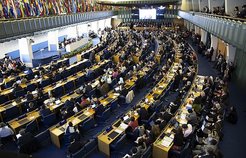From ambition to biodiversity action: Time to hold actors accountable

New global biodiversity goals are currently being negotiated. The photo shows the Open-ended Working Group on the Post-2020 Global Biodiversity Framework, Feb. 2020 in Rome. Photo: IISD/Mike Muzurakis (enb.iisd.org/biodiv/post2020/oewg/2/24feb.html)
To achieve global goals for biodiversity conservation, national level implementation must be significantly improved. National policy instruments need to precisely define effective actions and the actors responsible for implementation. Accountability needs to be ensured through systematic monitoring of progress. These recommendations are at the core of a 3-step framework proposed by an international team of scientists led by the German Centre for Integrative Biodiversity Research (iDiv), published in the journal Conservation Letters. The authors stress the need for urgency to avoid repeating failures of past international agreements and to move to effective implementation of agreed policy targets. One mistake in particular should be avoided.
Next spring, government envoys are convening at the UN Biodiversity Conference (COP 15) in Kunming, China, to negotiate new global biodiversity goals for the coming decades within the Convention on Biological Diversity (CBD). Looking back, the international community has repeatedly failed to reach most of its biodiversity targets. For instance, according to Eurostat, the populations of common farmland birds in Europe have declined by 17% since 2000. Continuous declines in biodiversity pose a major threat to human health and wellbeing.
A team of 55 scientists has now proposed a framework on how to effectively implement international biodiversity goals at the national and sub-national level. The framework consists of three interlinked steps:
Step one is to translate global targets into national targets and action plans, identifying clearly the sectors responsible for implementation; agriculture, infrastructure, trade, finance, and others. According to the authors, these action plans need to be co-designed by a wide range of actors from different sectors. This is to engender a strong, joint ownership of action plans and to overcome responsibility gaps. For instance, farmers’ associations should identify actions important for agro-biodiversity and for pollination services, or the financial sector should leverage investment decisions to foster social and environmental change.
Step two calls for implementing actions across sectors. This requires the full range of effective behavioural intervention tools to be employed – beyond simple awareness-raising. Here, a major challenge is the need to redesign existing regulatory frameworks, finance flows and network structures, which currently support actions harmful to biodiversity. This is the case for many subsidies, e.g., in agricultural policy. According to the scientists, effective finance mechanisms are needed to boost ecosystem restoration. Current CBD plans aim at placing 20% of degraded ecosystems under restoration by 2030. “We need to recover from past biodiversity loss and put ambitious restoration into action to bend the curve,” says Dr Andrea Perino, researcher at iDiv and first author of the publication. “Substantial investments by different sectors and comprehensive restoration plans will safeguard ecosystem health and human well-being into the future.”
Step three is about assessing the progress made and holding actors accountable. To enable accountability, countries must implement national biodiversity monitoring systems, the authors write. These monitoring systems should be able to trace biodiversity change back to sectors and administrative units, including production and consumption impacts. “There is one mistake we must not repeat, this is not precisely defining concrete target outcomes and responsible actors,” says Prof Henrique Pereira, corresponding author and research group head at iDiv and Martin Luther University Halle-Wittenberg. “A new framework that does not ensure accountability is doomed to failure. We need systematic and effective real-time monitoring: it is time to hold actors accountable.”
The scientists emphasise that these three steps are interlinked and must be refined with each implementation cycle. They are convinced that adopting this framework will move national and subnational governments forward in safeguarding national and global biodiversity. “We need to act boldly, now, to halt and reverse biodiversity loss,” says Prof Aletta Bonn, senior author and research group head at the Helmholtz Centre for Environmental Research – UFZ, the Friedrich Schiller University Jena and iDiv. “Governments need to systematically translate the global biodiversity goals into concrete national action, and ensure responsible accountability across sectors. We urge fast and reliable investments into securing our life-support system – for the future of our children.”
(Volker Hahn)
Original publication:
Perino, A., Pereira, H. M., Felipe-Lucia, M., Kim, H., Kühl, H. S., Marselle, M. R., Meya, J. N., Meyer, C., Navarro, L. M., v. Klink, R., Albert, G., Barratt, C. D., Bruelheide, H., Cao, Y., Chamoin, A., Darbi, M., Dornelas, M., Eisenhauer, N., Essl, F., Farwig, N., Förster, J., Freyhof, J., Geschke, J., Gottschall, F., Guerra, C., Haase, P., Hickler, T., Jacob, U., Kastner, T., Korell, L., Kühn, I., Lehmann, G. U. C., Lenzner, B., Marques, A., Motivans Švara, E., Quintero, L. C., Pacheco, A., Popp, A., Rouet-Leduc, J., Schnabel, F., Siebert, J., Staude, I. R., Trogisch, S., Švara, V., Svenning, J. C., Pe'er, G., Raab, K., Rakosy, D., Vandewalle, M., Werner, A. S., Wirth, C., Xu, H., Yu, D., Zinngrebe, Y. & Bonn, A. (2021):
Biodiversity post-2020: Closing the gap between global targets and national-level implementation.
Conservation Letters, DOI: 10.1111/conl.12848
